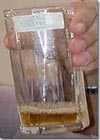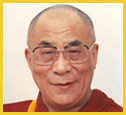|
Tibetan medicine is a science,
art and philosophy that provides a holistic approach to
health care. It is a science because its principles are
enumerated in a systematic and logical framework based on
an understanding of the body and its relationship to the
environment. It is an art because it uses diagnostic techniques
based on the creativity, insight, subtlety and compassion
of the medical practitioner. And it is a philosophy because
it embraces the key Buddhist principles of altruism, karma
and ethics.
Buddhist philosophy states that everything in the universe
is in a constant state of flux - that all phenomenon are
characterised by impermanence, and that the only permanent
feature is impermanence itself. As Buddha said, "No
matter whether perfect beings arise or not, it remains a
fact, and a hard necessity of existence, that all creations
are transitory." It is this impermanence that causes
each and every being to suffer at one stage or another.
Suffering is thus not accidental but springs from a specific
cause, whether from this life or a previous life. Only through
proper learning and the genuine practice of Dharma can liberate
from the vicious cycle of suffering.
Tibetan medical theory states that everything in the universe
is made up of the five proto-elements:
1. sa ( Earth )
2. chu ( Water )
3. me ( Fire )
4. rLung ( Wind )
5. Nam-mkha ( Space )
Although all five proto-elements are responsible for the
formation of each tissue cell, each element has a specific
influence:
1. sa exerts a greater influence over the formation of muscle
cells, bones, the nose and the sense of smell
2. chu is responsible for the formation of blood, body fluids,
tongue and the sense of taste
3. me is responsible for body temperature, complexion, the
eyes and the sense of sight
4. rLung is responsible for breathing, skin and the sense
of touch and
5. nam-mkha is responsible for body cavities, the ears and
the sense of hearing
The Three Principle Energy
1. rLung (wind) is one of the three principle energies
of the body which manifests the the nature of Air element.
It is characterised by rough, light, cold, subtle, hard
and mobile. It is responsible for the physical and mental
activities, respiration, expulsion of urine, faces, fetus,
menstruation, spitting, burping, speech, gives clarity to
sense organs, sustains life by means of acting as a medium
between mind and body.
2. mKhris-pa (Bile)basically has the nature of
fire. It is characterised by oily, sharp, hot, light, fetid,
purgative and fluidity. mKhris-pa is responsible for hunger,
thirst, digestion and assimilation, promotes bodily heat,
gives lustre to body complexion and provides courage and
determination.
3. Bad-kan (Phlegm) is cold in nature and is characterised
by oily, cool, heavy, blunt, smCTAh, firm and sticky. Bad-kan
is responsible for firmness of the body, stability of mind,
induces sleep, connects bodily joints, generates tolerance
and lubricates the body.
A Healthy Body:
gSowa rigpa (the art and science of healing or traditional
Tibetan medicine, astronomy and astrology) involves the
proper alignment of these divisions i.e. the 3 humors, 7
bodily constituents and 3 excretions, into a state of equilibrium.
If this is accomplished, then the body is said to be in
a state of health or free from psycho-physiological disorders;
whereas a disequilibrium in any of these energies constitutes
a state of disorder or ill-health.
Diagnosis in Tibetan Medicine
The diagnostic techniques include visual observation, touch
and interrogation.
Visual Observation
This involves checking a patient's skin complexion, the
colour and texture of his/her blood, nails, sputum, faeces,
and other general conditions. Special attention is paid
to the condition of the patient's tongue and urine.
i. Disorders of Tongue:
In wind disorder, the tongue will red, dry and rough. In
bile disorder, the tongue will be covered by a thick, pale
yellow coating of phlegm. In phlegm disorder, the tongue
will have a pale, thick coating of phlegm and dull, smCTAh
and moist texture.
ii. Urine Disorder:
The doctor advises the patient, how and when to collect
the urine sample. It is essential that patient avoid taking
too much of tea, buttermilk or wine etc. which otherwise
would cause discoloration of the urine sample. They are
also suggested to have a sound and sufficient sleep, refrain
from mental and emotional stress and desist irregular activities.
It is best to satisfy these conditions a night before the
examination. The urine in Wind disorder looks like water
and has large bubbles when stirred. In Bile, the urine is
reddish yellow and malodorous with much steam. In Phlegm,
the urine is whitish with little odour or steam.
 |
The first urine passed at
dawn is suitable for examination, since its colour is
not affected by digestion and by the colour the doctor
can detect diseases. The colour, steam and sediment
should be tested. The urine should be kept in a plain
container, so that the colour is not affected, and either
a stick or straw of white colour must be used for stirring
it during examination. |
Touch
Pulse reading forms the most important touching method employed in Tibetan medicine. Only after ensuring an important set
of preconditions, the physician proceeds with a pulse diagnosis.
This involves placing the index finger, middle finger and
ring finger of a doctor at patient's radial arteries. The
fingers must be held in a line close to one another yet
not touching each other. The index finger must not put too
much pressure on the skin; more pressure should be applied
by the middle and ring fingers.
Left hand of patient examined by the
right hand of the doctor
 |
a. the tip of the index
finger on the right side detects heart diseases and
on the left intestinal diseases
b. the tip of the middle finger on the right side
detects diseases affecting the spleen, and on the
left stomach diseases
c. the tip of the ring finger on the right side detects
kidney diseases and on the left diseases affecting
the seminal vessel |
Right hand of patient examined by the
left hand of the doctor
 |
d. the right tip of the
index finger detects lung diseases, the left tip diseases
affecting the guts
e. the right tip of the middle finger detects liver
diseases, the left tip diseases due to unbalanced
bile
f. the right tip of the ring finger detects kidney
diseases, and the left tip diseases affecting the
urinary bladder |
The right hand pulse should be examined
first in the case of female patients, and the left hand
one in the case of males. The reason for this is that the
tip of the female heart is tilted towards the right and
vice versa with males.
Interrogation
Interrogation forms the most important clinical aspect of
the diagnosis. There are three main elements to a medical
interrogation:
g. determining the causative factors
h. determining the site of the illness
i. studying the signs and symptoms - this involves the doctor
asking the patient about the sort of food and drink s/he
has been consuming, and what kind of physical and mental
behaviour s/he has been experiencing
Traditional Tibetan Medical Treatments
Dietary and Lifestyle Factors
At an immediate level, a disorder is primarily caused by
an improper diet and/or lifestyle. In fact, a majority of
health problems, both in developing and developed countries,
can be either directly or indirectly traced to poor diet
or lifestyle. Examples of this include alcoholism, hypertension
and heart disease. The first form of treatment in Tibetan
medicine is thus not medicines but changing a patient's
diet and/or lifestyle. Only if this fails to remedy an ailment
is the use of medicines considered.
Tibetan Medicines
Tibetan medicines take various forms, from decoctions, powders,
general pills, precious pills, and syrups, and are prescribed
in small doses -- a fact that reflects the emphasis Tibetan
medicine places on gentle treatment.
Moxibustion and Other Treatments
Many disorders, caused by proliferation of bad blood and
mKhris-pa are also treated by blood-letting at one of the
body's seventy seven blood-letting points. For cold disorders,
nerve malfunction and non-malignant tumors, moxibustion,
golden-needle therapy may be used to stimulate the energy
channels of the body. Many diseases of the nerves and muscles,
as well as pain and insomnia related to rLung, are treated
with gentle massage using various medicinal oils. Medicinal
bath and natural spring baths are used to treat an assortment
of skin disorders as well as chronic arthritis, gout and
cold types of rheumatism, and rigid and stiffness of the
extremities.
|

